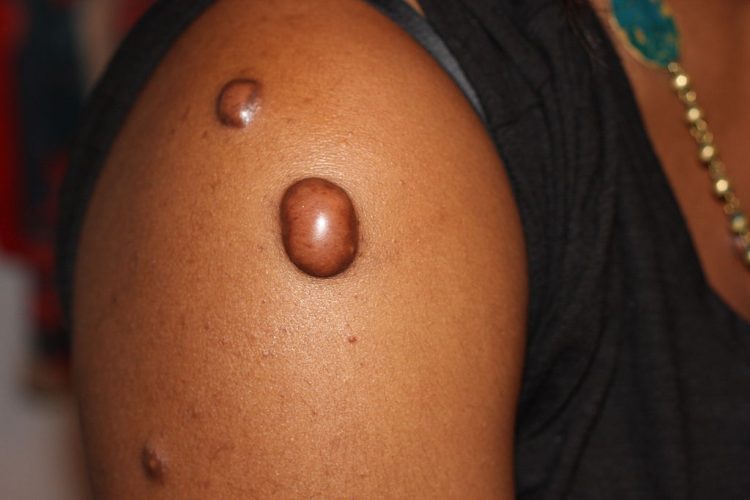Health
Skin Matters: What Are Keloids?
Keloids are raised thick scars which develop in the skin as a result of injury or surgery. The ability for keloids to develop is inherited. Keloids develop as a response to penetrating injury to the skin which leads to an abnormal scar. Keloids are scars that appear wider and more raised than flat scars.

[cs_content][cs_element_section _id=”1″][cs_element_row _id=”2″][cs_element_column _id=”3″][cs_text _order=”0″]
Keloids are raised thick scars which develop in the skin as a result of injury or surgery. The ability for keloids to develop is inherited. Keloids develop as a response to penetrating injury to the skin which leads to an abnormal scar. Keloids are scars that appear wider and more raised than flat scars.
Keloids may occur as a response to direct injury beneath the skin (cut), however, they may develop spontaneously, from acne and insect bites. Body piercing will lead to keloids in people who are prone to forming keloids. Tattooing of the skin does not lead to keloids; however, if a tattoo becomes traumatized or severely infected it might heal as a keloid.
Initially, keloids may be painful and itch. There are some African tribal rituals in which the skin on various parts of the face and body is intentionally cut in an effort to form “artistic” keloids. Unfortunately, there is no cure for keloids.
The predilection for keloids is genetic and they almost exclusively develop on the skin of people of African descent. There is an equal predilection for keloids in men and women. I very rarely see keloids in infants and prepubescent children. For unknown reasons, most keloids will not develop until puberty.
Keloids are extremely rare in elderly people in their seventh decade or older. Keloids have a predilection for forming on areas of the body such as the chest and shoulders where the skin is more likely to be stretch or pulled in various directions. Due to the perpetually loose skin around the eyelid and genitals , keloids are extremely rare in these areas of the body. Razor bumps (ingrown hairs) and plucking of unwanted hair can leads to scarring and formation of keloids.
The best treatment for keloids is to inject steroids into these thick scars which causes them to become less painful, softer, and smaller. I prescribe topical corticosteroid which is applied to the keloid at night.
Keloids on the earlobes can be surgically removed; however, repeated injection of corticosteroids into the resultant surgical scar is essential to minimize the reoccurrence of the keloid. Surgical treatment of keloids on the chest and shoulders in discouraged due their likelihood of reoccurrence. The use of lasers to treat or remove keloids is ineffective.
Why do keloids develop in people of African descent? Why don’t we see keloids in infancy prior to puberty? Why do we see a lesser occurrence of keloids in the elderly? Why don’t keloids form on eyelids and genitalia? Ongoing research has not led to the answers to these question; however, I believe that thousands of years ago keloids may have been a defense mechanism to minimize the systemic spread of life threatening tropical infections caused by insects bites.
Intense scarring around infected areas may have led to the prevention of systemic infection increased chance of survival. There is ongoing research regarding the genetics and prevalence of keloids in people with skin of color. Melanin causes darker skin and research is pointing to the possibility of a hormone known as melanocyte stimulating hormone (MSH) as a cause and may eventually lead to a cure for keloids.
Melanocyte stimulating hormone influences the fibroblasts in our skin to form collagen (connective tissue). MSH is not be as pronounced in childhood, but becomes more pronounced in puberty and adulthood. As we get older, perhaps MSH, along with other genetic factors become less pronounced, leading to a decrease incidence of keloids in the elderly.
As for the eyelids and genitalia, a study needs to be done to evaluate the difference in the connective tissue cells producing cells (fibroblasts) on the eyelids and genitalia as compared to other areas were keloids form more readily.
The bottom line is that keloids are a nemesis and the best way to prevent these scars is to avoid unnecessary surgery and body piercing. “An ounce of prevention is worth a pound of cure!”
Frederick N. Quarles, M.D. is a Board certified dermatologist, a Fellow of the American Academy of Dermatology, past chairman of the Dermatology Section of the National Medical Association, National Medical Association Practitioner of the Year (2008),and has been practicing dermatology in Tidewater Virginia for over 32 years. He can be reached at Virginia Dermatology and Skin Cancer Center (757) 455-5009.
[/cs_text][/cs_element_column][/cs_element_row][/cs_element_section][/cs_content]